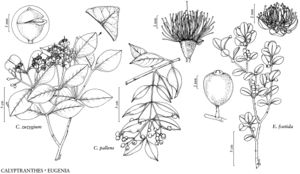Eugenia foetida
Syn. Pl. 2: 29. 1806.
Shrubs or trees, to 10 m, puberulent on young stems, leaves, and inflorescences, hairs pale, recurved and 0.2–0.4 mm, or erect and 0.1 mm. Twigs compressed; bark tan or gray. Leaves drying green, olive, or tan; petiole terete or channeled, 2–5 mm; blade elliptic or obovate, 2.5–8 × 0.8–3.5 cm, papery, base cuneate, decurrent along petiole, margins revolute, apex rounded or bluntly acute, occasionally ultimately retuse, surfaces with numerous, tiny glands, hairs scattered, erect or recurved, more dense along midvein and margins, or glabrate. Inflorescences (1 or )4–8-flowered, racemes, solitary or 2 or 3 superposed; axis 1–4 mm, puberulent, hairs straight and recurved; bud globose, 1 mm; bracteoles persistent, widely ovate, 0.5–0.7 × 0.7 mm, base distinct, margins scarious, apex acute, surfaces puberulent. Pedicels 1–3 mm. Flowers: hypanthium campanulate, 0.5–1 mm, pubescent; calyx lobes in about equal pairs, 0.5–1 × 0.5 –1 mm, margins ciliate, apex rounded, glabrous or with scattered hairs on outer surface; petals elliptic to widely ovate, 2–3.5 × 1.5–2.5 mm, margins ciliate, apex rounded; disc 1–1.5 mm diam.; stamens 25–30, 3–5 mm; style 4–6 mm. Berries black, globose, 4–6 mm diam.; calyx persistent, erect.
Phenology: Flowering and fruiting year-round.
Habitat: Coastal hammocks.
Elevation: 0–20 m.
Distribution
Fla., Mexico, West Indies, Central America (Belize, Guatemala).
Discussion
Eugenia foetida is known in the flora area from Brevard and Manatee counties southward.
Eugenia buxifolia (Swartz) Willdenow is an illegitimate later homonym of E. buxifolia Lamarck and a synonym of E. foetida.
Selected References
None.
